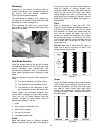
25
Resawing
Resawing is the process of slicing stock to
reduce its thickness, or to produce boards that
are thinner than the original workpiece.
Figure 36 demonstrates resawing.
The ideal blade for resawing is the widest one
the machine can handle, as the wider the blade
the better it can hold a straight line.
When resawing thin stock, use a push block,
push stick, or similar device to keep your hands
away from the blade.
Figure 36
Saw Blade Selection
Using the proper blade for the job will increase
the operating efficiency of your band saw, help
reduce necessary saw maintenance, and
improve your productivity. Thus, it is important to
follow certain guidelines when selecting a saw
blade.
Here are factors to consider when selecting a
blade:
The type of material you will be cutting.
The thickness of the workpiece or part.
The features of the workpiece or part,
such as bends or curves with small radii.
These factors are important because they
involve basic concepts of saw blade design.
There are five (5) blade features that are
normally changed to meet certain kinds of
sawing requirements. They are:
1. width
2. pitch (number of teeth per inch),
3. tooth form (or shape),
4. the "set" of the teeth
5. the blade material itself.
Width
Band saw blades come in different standard
widths, measured from the back of the blade to
the tip of the tooth. Generally, wider blades are
used for ripping or making straight cuts;
narrower blades are often used when the part
being cut has curves with small radii. When
cutting straight lines with a narrow blade, the
blade may have a tendency to wander, causing
blade lead. (refer to the Blade Lead section in
Adjustments).
Pitch
Pitch is measured in "teeth per inch" (TPI).
Figure 37 shows blades with different pitches. A
fine pitch (more teeth per inch) will cut slower
but smoother. A coarse pitch (fewer teeth per
inch) will cut rougher but faster. As a rule of
thumb, the thicker the workpiece, the coarser
will be the blade pitch. If you have to cut a hard
or very brittle material, you will probably want to
use a blade with a finer pitch in order to get
good clean cuts.
General rule: Use a blade that will have no
fewer than 6 and no more than 12 teeth in the
workpiece at any given time.
Figure 37
Shape
Figure 38 shows common types of tooth shape.
Tooth shape has an effect on cutting rate, and
with few exceptions, the Skip and Hook types
are used to obtain higher feed rates when
cutting thick workpieces. Variable-tooth blades
are also available, which combine features of
the other styles.
Figure 38


















